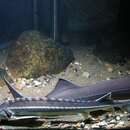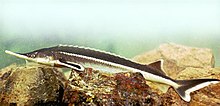en
names in breadcrumbs


Perception Channels: tactile ; chemical
Other Physical Features: bilateral symmetry
Acipenseriformes /æsɪˈpɛnsərɪfɔːrmiːz/ is an order of basal[1] ray-finned fishes that includes living and fossil sturgeons and paddlefishes (Acipenseroidei), as well as the extinct families Chondrosteidae and Peipiaosteidae.[2][3][4] They are the second earliest diverging group of living ray-finned fish after the bichirs. Despite being early diverging, they are highly derived, having only weakly ossified skeletons that are mostly made of cartilage, and in modern representatives highly modified skulls.[5]
The axial skeleton of Acipenseriformes is only partially ossified, with the majority of the bones being replaced with cartilage. The notochord, usually only found in fish embryos, is unconstricted and retained throughout life.[6] The premaxilla and maxilla bones of the skull present in other vertebrates have been lost. While larvae and early juvenile Acipenseriformes have teeth, the adults are toothless, or nearly so. The infraorbital nerve is carried by a series of separate canals, rather than being within the circumorbital bones. The palatoquadrate bones of the skull possess a cartilaginous symphysis (joint), and also have a broad autopalatine plate, as well as a narrow palatoquadrate bridge, and a quadrate flange. The quadratojugal bone is three-pointed (triradiate), and the dentition on the gill-arch is confined to the upper part of the first arch and to only the first and second hypobranchials.[5] Members of Acipenseriformes retain the ability to sense electric fields (electroreception) using structures called ampullae. This ability was present in the last common ancestor of all living jawed fish, but was lost in the ancestor of neopterygian fish.[7] All Acipenseriformes probably possessed barbels like modern sturgeon (which have four) and paddlefish (which have two).[5]
Acipenseriformes are assumed to have evolved from a "palaeonisciform" ancestor. Their closest relatives within the paleonisciformes are uncertain and contested.[5] Eochondrosteus from the Early Triassic of China has been suggested by some authors to be the oldest acipenseriform.[8] The oldest unambiguous members of the order are the Chondrosteidae, a group of large fish found in marine deposits from the Early Jurassic of Europe, which already have reduced ossification of the skeleton.[9] The Peipiaosteidae are known from Middle Jurassic-Early Cretaceous freshwater deposits in Asia.[10] The oldest known paddlefish is Protopsephurus from the Early Cretaceous of China,[11] while the earliest known sturgeons appear in the Late Cretaceous in North America and Asia.[12]
Most living species of Acipenseriformes are classified as threatened (mostly endangered or critically endangered) by the International Union for Conservation of Nature.
The Chinese paddlefish was last seen alive in 2003, and was considered to have gone extinct sometime between 2005 and 2010 by the Yangtze River Fisheries Research Institute in their 2019 report.
A study published in 2020 reported a successful hybridization between a Russian sturgeon (Acipenser gueldenstaedtii) and an American paddlefish (Polyodon spathula), indicating that the two species can breed with one another despite their lineages having been separated for hundreds of millions of years. This has marked the first successful hybridization between members of Acipenseridae and Polyodontidae.[14]
 Fossil of the †chondrosteid †Strongylosteus hindenburgi, Tübingen
Fossil of the †chondrosteid †Strongylosteus hindenburgi, Tübingen  Fossil of the †peipiaosteid †Yanosteus longidorsalis, MHNT
Fossil of the †peipiaosteid †Yanosteus longidorsalis, MHNT  The living polyodontid Polyodon spathula (American paddlefish)
The living polyodontid Polyodon spathula (American paddlefish)  The living acipenserid Acipenser ruthenus (sterlet)
The living acipenserid Acipenser ruthenus (sterlet)  The living acipenserid Pseudoscaphirhynchus kaufmanni (false shovelnose sturgeon)
The living acipenserid Pseudoscaphirhynchus kaufmanni (false shovelnose sturgeon) Acipenseriformes /æsɪˈpɛnsərɪfɔːrmiːz/ is an order of basal ray-finned fishes that includes living and fossil sturgeons and paddlefishes (Acipenseroidei), as well as the extinct families Chondrosteidae and Peipiaosteidae. They are the second earliest diverging group of living ray-finned fish after the bichirs. Despite being early diverging, they are highly derived, having only weakly ossified skeletons that are mostly made of cartilage, and in modern representatives highly modified skulls.